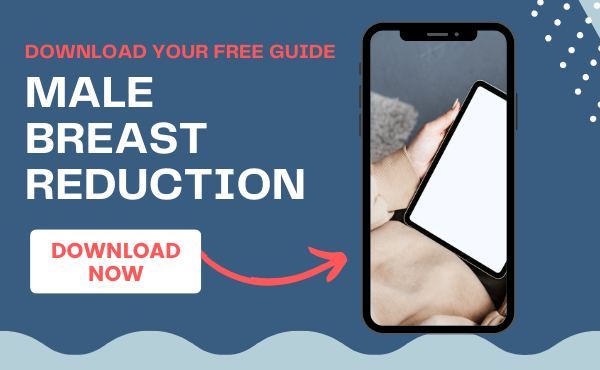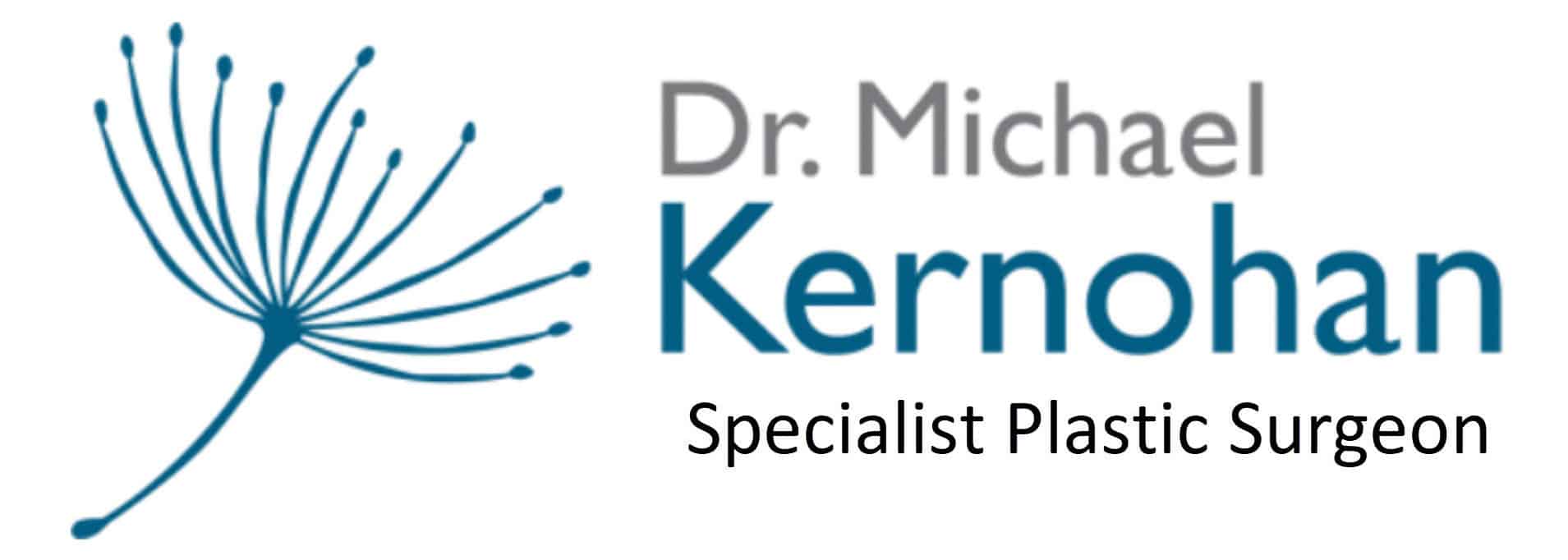Causes and Solutions for Gynaecomastia – Enlarged Breasts in Men
Gynaecomastia is a medical condition that might not be widely discussed, but it’s more common than many realise. In simple terms, it’s the enlargement of breast tissue in males. This condition can affect men and boys at different stages of their lives, and it’s important to understand that it’s not just a cosmetic concern but a medical one. In this blog, Sydney Plastic Surgeon Dr Michael Kernohan will explore what causes gynaecomastia and look at the various solutions available to those who are dealing with it.
Download Dr Kernohan’s Male Breast Reduction Guide

Causes of Gynaecomastia
At its core, gynaecomastia involves the development of excess glandular tissue in the male breast, a condition distinct from pseudo gynaecomastia, where fat deposition occurs in overweight individuals. This enlargement in gynaecomastia is primarily due to an imbalance between the hormones oestrogen and testosterone, both of which are present in men and women. Oestrogen stimulates breast tissue growth, while testosterone works to inhibit it. When the balance shifts towards oestrogen, breast tissue can grow. Gynaecomastia can manifest at any stage of life: in newborns, it’s often caused by maternal oestrogen; during puberty, hormonal changes can lead to temporary imbalances; and in older men, a decrease in testosterone levels coupled with increased body fat can elevate oestrogen levels. Additionally, certain medications, illegal drugs, and various health conditions can also trigger the development of gynaecomastia.
Hormonal Imbalances
The primary cause of gynaecomastia is an imbalance between the hormones oestrogen and testosterone. Both men and women have these hormones, but in different proportions. Oestrogen controls breast tissue growth, while testosterone inhibits it. When the balance shifts in favour of oestrogen, breast tissue can grow. This imbalance can occur naturally at different life stages, such as during infancy, puberty, and older age. However, certain conditions and lifestyle choices can also disrupt this hormonal balance.
Medications and Drugs
Various medications and substances can contribute to the development of gynaecomastia. These include:
- Anabolic Steroids: Often used for bodybuilding, these can disrupt hormone levels
- Alcohol: Excessive alcohol consumption can affect liver function, which in turn can influence hormone levels
- Medications for Heart Conditions: Some drugs used to treat heart conditions, like digoxin and calcium channel blockers, can lead to gynaecomastia
- Anti-Ulcer Drugs: Certain medications used to treat stomach ulcers and acid reflux, such as cimetidine, have been linked to this condition
- Anti-Androgens: Used to treat prostate enlargement and cancer, these can also cause gynaecomastia
- HIV Medication: Some treatments for HIV/AIDS can affect hormone levels
It’s important to review any medications you’re taking with your surgeon if you’re concerned about gynaecomastia.
Health Conditions
Several health conditions can lead to the development of gynaecomastia, including:
- Liver Diseases: Conditions like cirrhosis can disrupt hormone processing
- Kidney Failure: Impaired kidney function can lead to changes in hormone levels
- Thyroid Disorders: Thyroid hormones play a role in regulating overall hormone balance
- Obesity: Excess fat can lead to increased production of oestrogen
- Tumours: Certain tumours, especially those affecting the testes, adrenal glands, or pituitary gland, can produce hormones that cause gynaecomastia
Age-Related Changes
Gynaecomastia can also be a part of normal ageing. As men get older, testosterone levels naturally decline while body fat, which can produce oestrogen, tends to increase. These changes can upset the hormonal balance and lead to breast tissue growth.
Differentiating Gynaecomastia from Similar Conditions
It’s essential to distinguish gynaecomastia from other conditions that cause breast enlargement in males. The most common confusion is with pseudo gynaecomastia, which, as mentioned, is due to excess fat and not glandular tissue growth. Pseudo gynaecomastia is often associated with obesity and doesn’t have the same hormonal underpinnings as gynaecomastia.
Another condition to be aware of is breast cancer, which, although rare in men, can be mistaken for gynaecomastia. Breast cancer in men typically presents as a hard, one-sided lump in the breast tissue, unlike the more uniform enlargement seen in gynaecomastia.
Knowing whether you’re dealing with gynaecomastia or another condition is key to choosing the right treatment approach. For instance, weight loss might reduce breast size in pseudo gynaecomastia, but it won’t have the same effect on gynaecomastia. Similarly, while most cases of gynaecomastia are benign, identifying and treating breast cancer early is critical for health outcomes.
Male Breast Reduction Surgery
Male breast surgery, often referred to as male breast reduction or gynaecomastia surgery, is a medical procedure aimed at reducing breast size in men, flattening and enhancing the chest contours. In most cases, this surgery involves the removal of excess fat, glandular tissue, and sometimes skin.
Preparing for male breast surgery involves several steps to ensure your safety and the success of the procedure. Firstly, a medical evaluation is conducted to confirm your fitness for surgery. This might include a range of lab tests to assess your overall health status. Additionally, you may need to adjust your current medication regimen, either by modifying dosages or temporarily stopping certain medications, as recommended by Dr Kernohan. This is to minimise any potential risks during and after the surgery. Another vital aspect of preparation involves lifestyle changes, particularly ceasing smoking and reducing alcohol intake. Smoking can impede healing and increase the risk of complications, while alcohol can affect your body’s response to anaesthesia and recovery. Lastly, it’s important to plan for post-surgery assistance. This means arranging for someone reliable to drive you home after the procedure and to provide support during the initial recovery phase, when you might not be fully mobile or able to perform regular activities.
The Surgical Process
The techniques used in this surgery are diverse, each chosen based on the extent of breast tissue to be removed and your unique body structure. Primarily, the procedure may involve liposuction, excision, or a combination of both. Liposuction is particularly effective for removing excess fatty tissue. In this technique, a cannula (a thin tube) is inserted through small incisions, and fat is suctioned out. This method is less invasive and typically used when there is a significant amount of fatty tissue, but minimal glandular tissue. On the other hand, excision techniques are necessary when the removal of glandular breast tissue or excess skin is required. This might be the case if you’re experiencing sagging or stretching of the areola.
Generally, male breast surgery is performed under general anaesthesia, which means you’ll be asleep throughout the procedure. Dr Kernohan will make incisions around the areola or within the natural creases of your chest, striving to minimise visible scarring. The location and length of these incisions depend on the amount and location of excess tissue and your specific anatomy.
Throughout the procedure, Dr Kernohan’s priority is not only to achieve a more masculine chest contour but also to ensure symmetry, natural appearance, and minimal scarring. You’ll be provided with detailed post-operative care instructions, which are integral to a smooth and successful recovery. It’s important to follow these guidelines closely to ensure optimal healing and achieve the best possible results.
More about Treatment Options for Gynaecomastia
If you’re dealing with gynaecomastia, it’s understandable that you might be seeking effective ways to manage or treat the condition. Fortunately, there are several approaches you can take, ranging from lifestyle changes to medical treatments:
- Diet: Focus on a balanced diet that supports overall health. Aim for a variety of fruits, vegetables, lean proteins, and whole grains. Reducing foods high in sugar and fat can help manage body weight and potentially reduce the appearance of gynaecomastia. Remember, a healthy diet is about balance and moderation, not deprivation
- Exercise: Regular exercise can help in two ways. Firstly, it can aid in weight loss, which might reduce the appearance of gynaecomastia if it’s related to excess body fat. Secondly, certain exercises, particularly strength training, can help tone the chest muscles, making gynaecomastia less noticeable. However, it’s important to note that exercise alone won’t completely resolve the condition if it’s due to glandular tissue growth
- Alcohol and Drugs: Reducing alcohol consumption and avoiding drugs known to contribute to gynaecomastia, such as anabolic steroids and certain medications, can be beneficial. If you’re taking prescription medications that you suspect might be contributing to the condition, discuss alternatives with your doctor
- Medications: Certain medications can help treat gynaecomastia, especially if it’s caught early. These might include drugs that adjust hormone levels or block oestrogen effects in the body
FAQs about Gynaecomastia Causes

How can I tell if I have gynaecomastia or just extra fat?
- Gynaecomastia is characterised by the presence of firm glandular tissue in the breast area, which is different from the softer, more pliable feel of extra fat. This glandular tissue typically forms a rubbery or firm mass that extends concentrically from the nipples. Extra fat in the chest area, on the other hand, is usually part of overall body fat and doesn’t have this concentrated, firm texture. A healthcare professional can perform a physical examination, which may include palpation of the breast tissue, to determine if your condition is gynaecomastia. In some cases, imaging tests like ultrasound or mammography might be used to confirm the diagnosis.
Is gynaecomastia common in teenage boys?
- Yes, gynaecomastia is quite common during puberty due to hormonal fluctuations. As boys go through puberty, their bodies produce more oestrogen, which can sometimes lead to the development of breast tissue. In most cases, this condition is temporary and resolves on its own as hormone levels stabilise, usually within six months to two years.
Can gynaecomastia go away on its own?
- Gynaecomastia, particularly in teenage boys, often resolves on its own without the need for treatment. This natural resolution is due to the stabilisation of hormone levels after puberty. However, in adults, the condition is less likely to go away on its own, especially if it has been present for a long time. Persistent gynaecomastia in adults may require medical intervention or lifestyle changes for improvement or resolution.
Are there any lifestyle changes I can make to reduce gynaecomastia?
- To manage gynaecomastia, adopting a healthy lifestyle can be beneficial. This includes a balanced diet rich in nutrients, regular physical activity, particularly exercises that target the upper body, which can help tone the chest muscles. Reducing alcohol intake is also recommended, as alcohol can affect hormone levels. Additionally, avoiding drugs and medications known to cause gynaecomastia, such as anabolic steroids and certain hormonal medications, can prevent the condition from worsening.
Is surgery for gynaecomastia safe?
- Surgery for gynaecomastia, like any surgical procedure, carries certain risks. The most common surgical procedures for gynaecomastia are liposuction, which removes excess fat, and mastectomy, which involves the removal of excess glandular tissue. Potential risks include infection, scarring, and changes in breast or nipple sensation. It’s crucial to have a thorough discussion with Dr Kernohan about the potential risks and benefits, as well as your expectations from the surgery, to make an informed decision.Top of FormBottom of Form
Further Reading about Gynaecomastia with Sydney Plastic Surgeon Dr Michael Kernohan
- Read Dr Kernohan’s Blog on Gynaecomastia Scars – Treatment, Healing and Fading
- Read Dr Kernohan’s Blog on What Causes Enlarged Breasts in Men?
- Read Dr Kernohan’s Blog on Plastic Surgery Risks and Complications
- Read Dr Kernohan’s Blog on FTM/N Top Surgery Scars – Treatment, Healing and Fading
- Read Dr Kernohan’s Blog on Will Medicare Cover My Gynaecomastia Surgery?
- Read Dr Kernohan’s Blog on Plastic Surgery for Men in Sydney
- Read Dr Kernohan’s Blog on Cosmetic Surgery for Men in Sydney
Medical References about Gynaecomastia
- Enlarged breasts in men (gynaecomastia) – Mayo Clinic
- Gynaecomastia: Surgery, treatment, causes, and symptoms – Medical News Today
- Gynaecomastia Surgery (Male Breast Reduction): What to Expect -Cleveland Clinic
- Trends in the Surgical Correction of Gynaecomastia – NCBI
- Surgical Management of Gynaecomastia: An Outcome Analysis – PubMed





